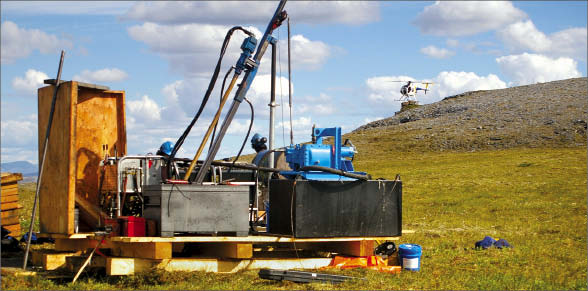While other companies explore emerging Yukon gold belts – such as the White Gold district and the Selwyn Basin – in their hunt for the next big Arctic gold deposit, Cedar Mountain Exploration (CED-V) has its sights set on an even loftier target: to discover a new gold district altogether.
The company started its first-ever drill program last month since listing four years ago. The program comprises 5,000 metres of diamond core drilling on three multi-kilometre-long gold targets at its Kelly Creek property in western Alaska. The 426-sq.-km, 50-km-long land package is located on the Seward Peninsula, 145 km north of the coastal town of Nome.
In 2010, Cedar Mountain spent close to $600,000 taking 1,700 soil, stream sediment and rock samples to outline seven gold-in-soil anomalies: Kelly Creek, Wolf, Wolverine, South Fox, North Fox, Moose and Jaeger.
Kelly Creek, Wolf and Wolverine will be subject to the current drill program. Soil grids and geologic mapping were completed on the remaining anomalies in June, and the company anticipates drillable status before 2012. Around 1,500 samples will be collected from eight other areas during the year’s short exploration season in search of future drill targets.
Cedar Mountain is now looking to prove that the initial targets host a near-surface, bulk-tonnage disseminated gold deposit.
As with many new greenfield projects in today’s rush for gold, Kelly Creek had been briefly explored before. Anaconda found gold mineralization there while exploring for tin in the early 1980s. It drilled two holes in a mineralized zone at Kelly Creek, returning 24 metres of 1.07 grams gold per tonne and 32 metres of 0.83 grams gold, before it was shut down by its parent ARCO in 1985.
Cedar Mountain describes gold mineralization at Kelly Creek as being hosted in a metamorphosed lower Paleozoic carbonate-shale shelf-to-basinal sequence, and associated with the intersection of specific stratigraphic horizons and secondary fault splays. While a winter trail runs through the property’s eastern boundary, the current exploration program will be based out of a new 24-person camp near the company’s 800-metre airstrip. Drilling will be supported by all-terrain vehicles and helicopter.
Led by president and CEO Charles Chebry, Cedar Mountain is one of eight juniors managed by the Vancouver-based Discovery Group, which was started in 2005 by geologists John Robins and John Williamson. The group’s biggest success has been Yukon gold- finder Kaminak Gold (KAM-V), which is spending $15 million this year proving up eight gold discoveries drilled in 2010, at its Coffee gold project in the White Gold district.
Shares of Cedar Mountain closed up 2¢ to 22¢ on 42,000 shares traded on July 19, well within their 52-week range of 13.5¢-35¢. The company has 52.6 million shares outstanding and 87.2 million fully diluted, of which management and directors own approximately 22%.


Be the first to comment on "Cedar Mountain drills untested Alaskan gold anomalies"